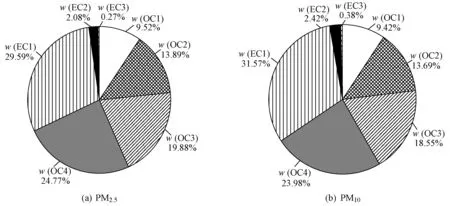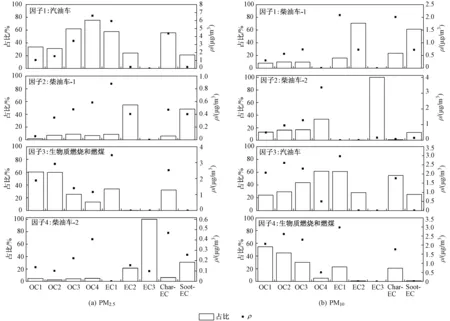菏泽市冬季大气PM2.5和PM10中碳组分来源解析
2017-11-10张家营刘保双毕晓辉吴建会冯银厂张裕芬张勤勋
张家营, 刘保双, 毕晓辉, 吴建会*, 冯银厂, 张裕芬, 张勤勋
1.南开大学环境科学与工程学院, 国家环境保护城市空气颗粒物污染防治重点实验室, 天津 300350 2.菏泽市环境监测站, 山东 菏泽 274000
菏泽市冬季大气PM2.5和PM10中碳组分来源解析
张家营1, 刘保双1, 毕晓辉1, 吴建会1*, 冯银厂1, 张裕芬1, 张勤勋2
1.南开大学环境科学与工程学院, 国家环境保护城市空气颗粒物污染防治重点实验室, 天津 300350 2.菏泽市环境监测站, 山东 菏泽 274000
为研究菏泽市冬季大气颗粒物中碳组分的污染特征和来源,于2016年1月采集菏泽市冬季大气PM2.5和PM10样品,基于热光反射法分析样品中OC(有机碳)、EC(元素碳)及8个碳组分〔OC1、OC2、OC3、OC4、EC1、EC2、EC3和OP(裂解碳)〕的含量,并计算得到ρ(Char-EC)(Char-EC为燃料燃烧后固体残渣中的EC)和ρ(Soot-EC)(Soot-EC为燃烧后气相挥发物质再凝结形成的EC),以定性识别大气颗粒物中碳组分的来源. 结果表明,菏泽市冬季大气颗粒物样品中碳组分浓度处于较高水平,PM2.5中的ρ(OC)、ρ(EC)分别为26.34、9.22 μgm3,PM10中ρ(OC)、ρ(EC)分别为31.82、10.71 μgm3. 采样期间大气PM2.5中碳组分(OC、EC、OC1、OC2、OC3、OC4、EC1、EC2、EC3、Char-EC、Soot-EC)浓度与PM10中相应各组分浓度的比值均大于0.5(0.60~0.90),表明碳组分多集中于细粒子(PM2.5). 大气颗粒物样品中各碳组分浓度具有明显空间差异,各点位大气PM2.5和PM10中ρ(OC)均显著高于ρ(EC)(T检验,P<0.05). 菏泽市冬季大气PM2.5和PM10中Char-ECSoot-EC(二者质量浓度之比)分别为10.04、8.00,并且存在显著的空间差异性(T检验,P<0.05). PMF(正定矩阵因子分解法)解析结果表明,菏泽市冬季大气PM2.5和PM10中碳组分来源主要有4类,包括两类柴油车(1类排放的碳组分中以EC2为主,定义为柴油车-1;1类排放的碳组分中以EC3为主,定义为柴油车-2)、汽油车、生物质燃烧和燃煤混合源,对大气PM2.5中碳组分的分担率分别为13.98%、5.13%、24.47%、41.97%,对大气PM10中碳组分的分担率分别为16.08%、8.21%、18.34%、47.35%. 可见,菏泽市冬季大气PM2.5和PM10中碳的主要来源是柴油车、汽油车、生物质燃烧和燃煤.
菏泽市; 颗粒物; 碳组分; 源解析; PMF模型
随着中国经济的快速发展和化石能源的大量消耗,导致大量碳组分的排放,很多地区大气颗粒物中碳组分的占比持续增加[1]. 碳组分是颗粒物的重要组成部分,对雾霾的形成、气候的改变和人体健康的危害有重要的影响[2-6]. 大气颗粒物中碳组分的来源主要包括燃煤、机动车、生物质燃烧等[7-8],其组成主要包括OC(有机碳)和EC(元素碳). 研究大气颗粒物中碳组分的污染特征及来源,对于认识区域和城市大气污染状况、搞好污染控制有重要的意义[9].
近年来,很多研究试图利用OC/EC(质量浓度之比)来定性识别大气颗粒物中碳组分的来源[10-11]. 如王伟等[12-15]利用OC/EC定性分析了鞍山、黄石、武汉、天津等城市大气颗粒物中碳组分的主要来源,结果表明,机动车尾气尘、生物质和燃煤尘是大气颗粒物中碳组分的主要排放源. 然而,基于OC/EC进行的源解析存在较大不确定性,因为OC/EC一般会受到一些因素的影响,如SOA(二次有机气溶胶)的形成等[16]. 因此,一些研究试图通过使用Char-EC/Soot-EC(Char-EC为燃料燃烧后固体残渣中的EC,Soot-EC为燃烧后气相挥发物质再凝结形成的EC,此处为二者质量浓度之比)进行源识别. HAN等[17]用Char-EC/Soot-EC解析出生物质燃烧和燃煤对内蒙古冬季大气颗粒物中碳组分贡献较大. HAN等[18]研究了我国14个城市大气颗粒物中Char-EC/Soot-EC,结果表明,Char-EC/Soot-EC的变化规律和源解析结果变化规律一致. CAO等[7]通过研究西安市大气颗粒物中碳组分,得出生物质燃烧的Char-EC/Soot-EC为11.6,燃煤的Char-EC/Soot-EC为1.9. 尽管如此,OC/EC与Char-EC/Soot-EC方法尚不能定量解析大气颗粒物中碳组分的来源,并且存在较大不确定性[18]. 因此,一些研究开始利用受体模型进行大气颗粒物中碳来源的定性定量分析研究,如CAO等[7,19-20]把7种碳组分(OC1、OC2、OC3、OC4、EC1、EC2、EC3)纳入绝对主成分分析模型解析了西安、天津、上海等城市大气颗粒物中碳的来源,研究表明,燃煤(分担率为37%~44%)、生物质燃烧(4%~22%)、汽油车和柴油车排放(15%~73%)是大气颗粒物中碳组分的主要来源. ZHENG等[1,22]通过CMB(化学质量平衡)模型分别得到田纳西河谷地区、美国东南部木材燃烧对大气颗粒物中碳的贡献最大(分担率为25%~66%),其次是汽油车和柴油车的排放(10%~66%). WANG等[22]通过PMF(正矩阵因子分解)模型得到柴油车排放(分担率为37.5%)和生物质燃烧(24.6%)是三亚PAHs的主要来源. 可以看出,大气颗粒物中碳组分的来源解析研究已受到国内外越来越多的关注. 但是,运用PMF模型进行多粒径段碳组分来源解析的研究较少.
PMF模型具有不需依赖源成分谱、分解矩阵中元素非负、能够确定污染源及其贡献的优点[14]. 另外,EPA PMF 5.0版本中有三种误差评估(error estimation, EE)方法,可以减少PMF分析的不确定性[23]. 因此,利用PMF模型对大气颗粒物中碳组分进行来源解析是一种有效的方法[24]. 尽管如此,基于PMF模型的大气颗粒物中碳组分来源解析的研究仍然是有限的.
菏泽市是山东省西南部的中等农业城市. 随着经济快速增长和城市化进程的加快,化石燃料被大量消耗,2014年菏泽市燃料煤的消耗量近750×104t. 化石燃料的使用会排放大量的碳气溶胶进入环境空气中[25],对公共健康、大气能见度以及环境气候产生不利影响[14,26]. 该研究拟利用OC/EC、Char-EC/Soot-EC和PMF模型定性定量分析菏泽市颗粒物中碳组分来源,以期为菏泽市政管理部门控制和防治污染源提供依据.
1 样品采集与方法
1.1大气PM2.5和PM10样品采集
根据菏泽市污染源排放及功能区分布等,选取6个采样点〔华润制药(35°15.38′N、115°30.95′E)、西城水库(35°15.21′N、115°23.17′E)、污水处理厂(35°13.35′N、115°31.60′E)、牡丹高新区(35°14.64′N、115°24.46′E)、菏泽学院(35°16.16′N、115°27.60′E)和市政协(35°14.25′N、115°28.48′E)〕采集大气PM2.5和PM10样品. 于2016年1月14—23日进行采样,每天连续采样23 h(当日10:00—翌日09:00). 其中华润制药采样点为交通、工业混合区;西城水库采样点为农村地区;污水处理厂和牡丹高新区采样点为交通、住宅混合区;菏泽学院采样点为教育、住宅和商业混合区;市政协采样点为住宅、商业混合区. 采样点均设置在距离地面5~10 m的楼顶平台.
在6个采样点采用TH-150C型智能中流量采样器(武汉天虹仪表有限公司)同时采集大气中PM2.5和PM10样品. 采样器的流量为100 L/min,共获得PM2.5有效样品59个,PM10有效样品60个. 采样期间,菏泽市的平均温度为0.14 ℃、平均相对湿度(RH)为49.41%、ρ(SO2)为65.17 μg/m3、ρ(NO2)为51.50 μg/m3. 菏泽市冬季盛行西北风、南风和东风,平均风速(WS)为1.9 m/s.
1.2OC和EC分析
该研究采用美国沙漠研究所研制的DRI Model 2001A型热光分析仪,基于热光反射法分析大气PM2.5和PM10中的碳组分[18]. 从滤膜上截取0.558 cm2待测样品送入热光分析仪,在纯氦气环境下,于140 ℃(OC1)、280 ℃(OC2)、480 ℃(OC3)和580 ℃(OC4)热解有机碳,然后在含氧气(2%)和氦气(98%)环境下,于580 ℃(EC1)、740 ℃(EC2)和840 ℃(EC3)逐步加热氧化元素碳. 采用633 nm的He-Ne激光照射样品,检测无氧加热下OP(裂解碳)的生成量[17]. OC的定义为OC1+OC2+OC3+OC4+OP,EC的定义为EC1+EC2+EC3-OP,Char-EC的定义为EC1-OP,Soot-EC的定义为EC2+EC3.
每个采样时段均采集两个现场空白滤膜,测定单位面积滤膜上OC、EC含量的平均值作为该时段样品本底值扣除. 单位面积空白滤膜上OC和EC含量分别为0.7~0.8和0~0.06 μg/cm2,低于实际样本的5%和1%. 每个采样时段均采集2~3个平行样品,用于采样现场和实验室分析的全过程质量控制. 平行样中测得的单位面积滤膜上OC和EC含量相对偏差均在10%以内. OC和EC的方法检出限(MDLs)分别为0.45和0.06 μg/cm2.
1.3PMF模型
PMF模型利用权重计算出颗粒物中各化学组分的误差,然后通过最小二乘法来确定颗粒物的主要污染源及其贡献[17]. PMF的基本原理是将多样本、多物种的采样数据看作是一个n×m的X(i×j)矩阵[27],样本的实测质量浓度Xij表达为
(1)
X=GF+E
(2)
式中,i为受体样本,j为物种,p为污染源数,g为源对受体的相对贡献,f为污染源中某物种的含量,eij为实测的样本质量浓度与其解析值的残差[28]. 式(2)表示原始矩阵X可以分解为两个因子矩阵——源贡献矩阵G(i×k)、源成分谱矩阵F(k×j)以及一个残差矩阵E(i×j).
PMF模型通过定义一个目标函数Q,最终解析得到使目标函数Q值最小的G矩阵和F矩阵[29],从而得到最优的因子解析结果:
μij)2
(3)
式中,μ为样本的不确定度.
该研究采用Paatero等[30]提出的共轭梯度算法以最大限度地减小目标函数Q〔见式(4),这种方法是以估算的数据的不确定性(或调整的数据的不确定性)为基础的〕,从而确定污染源贡献矩阵G和污染源成分矩阵F.
(4)
EPA PMF5.0包括三种误差评估(EE)方法——BS(Bootstrap)、DISP (Displacement)、BS-DISP[23,31]. BS是一种自举的分析方法,受随机误差和旋转不确定性的影响[29];DISP是一种替换分析的方法,受旋转不确定性的影响,但不受随机误差影响[32];BS-DISP则结合BS和DISP两种方法.
SN(信噪比)是PMF模型中用来消除弱变量的,信号矢量被定义为S,噪声矢量被定义为N,SN的定义[33]:
SN=
(5)
式中,sl和nl分别为PM2.5和PM10中的碳组分l的信号和噪声. 当SN≤0.2时,在PMF的输入数据统计表中设置该变量为“bad”,使得该组分不会被纳入分析中;当0.2 2.1大气PM2.5和PM10中碳组分特征 菏泽市冬季大气PM2.5中ρ(OC)、ρ(EC)分别为26.34、9.22 μg/m3,PM10中ρ(OC)、ρ(EC)分别为31.82、10.71 μg/m3;PM2.5中ρ(OC)、ρ(EC)与PM10中ρ(OC)、ρ(EC)的比值分别为0.83、0.86,说明OC、EC多集中于细粒子(PM2.5). 菏泽市冬季大气PM2.5与PM10中7种碳组分的构成见图1. PM2.5与PM10碳组分中,ρ(EC1)分别为10.52、13.43 μg/m3,并且w(EC1)最高,分别为29.59%、31.57%(见图1),EC1主要来自于燃煤排放[35],表明菏泽市冬季大气颗粒物中碳组分可能受燃煤影响较大. PM2.5与PM10中ρ(OC4)分别为8.81、10.20 μg/m3,w(OC4)分别为24.77%、23.98%,仅次于w(EC1),与成都[36]、南京[37]类似.w(OC1)、w(EC2)、w(EC3)均较低(分别为9.42%~9.52%、2.08%~2.42%、0.27%~0.38%). PM2.5与PM10中ρ(OC1)、ρ(OC2)、ρ(OC3)、ρ(OC4)、ρ(EC1)、ρ(EC2)、ρ(EC3)、ρ(Char-EC)、ρ(Soot-EC)的比值均大于0.5(0.60~0.90),其中ρ(OC3)比值(0.90)最大,ρ(EC3) 比值(0.60)最小,说明这些碳组分多集中于细粒子(PM2.5)上. 与国内其他城市相比,菏泽市冬季大气PM2.5中ρ(OC)、ρ(EC)高于泰安、南京、上海、杭州,低于广州、北京;PM10中ρ(OC)、ρ(EC)高于泰安、南京、上海、杭州、北京,低于广州(见表1). 此外,大气PM2.5与PM10中OC/EC高于泰安、南京、上海、广州. 与国外城市相比,菏泽市大气颗粒物中ρ(OC)、ρ(EC)处于较高水平. 由此可见,各城市间大气颗粒物中碳组分的含量存在明显差异,这可能与排放源、气象条件的差异以及区域传输有关. 图1 菏泽市冬季大气PM2.5与PM10中七种碳组分的质量分数Fig.1 Mass fraction of seven carbon fraction in PM2.5 and PM10 in winter of Heze 表1 国内外主要城市大气颗粒物中ρ(OC)、ρ(EC)和OCEC平均值 Table 1 Mass concentrations of OC and EC and the average ratios of OCEC in other cities 表1 国内外主要城市大气颗粒物中ρ(OC)、ρ(EC)和OCEC平均值 城市ρ(OC)∕(μg∕m3)ρ(EC)∕(μg∕m3)OC∕EC颗粒物季节数据来源菏泽2634922286PM25冬季该研究菏泽31821071297PM10冬季该研究泰安1016391260PM25冬季文献[37]南京13853260PM25冬季文献[38]上海169100169PM25冬季文献[39]杭州17136475PM25冬季文献[40]广州17541427PM25冬季文献[41]北京245819299PM25冬季文献[41]美国丹佛337044770PM25夏季文献[42]比利时根特4110410PM25冬季文献[43] 菏泽市冬季大气颗粒物中碳组分的空间分布特征如图2所示. 在6个采样点中,PM2.5和PM10中ρ(OC)均明显高于ρ(EC)(T检验,P<0.05),这是由大气化学反应和大量的人为排放源造成的[44]. 菏泽学院采样点PM2.5和PM10中ρ(OC)、ρ(EC)、ρ(OC2)、ρ(OC3)、ρ(EC1)、ρ(Char-EC)最高;华润制药采样点PM2.5和PM10中ρ(OC1)、ρ(OC4)、ρ(EC2)、ρ(Soot-EC)最高;西城水库采样点PM2.5中ρ(OC1)、ρ(OC2)、ρ(OC3)、ρ(OC4)、ρ(EC1)、ρ(EC2)、ρ(Char-EC)、ρ(Soot-EC)最低,这是因为西城水库为农村地区,碳气溶胶的排放较少;华润制药采样点PM10中ρ(OC)、ρ(OC1)、ρ(OC4)最低. 图2 不同采样点的碳组分质量浓度Fig.2 The concentrations of carbonaceous species at different sampling sites 采样期间,菏泽市大气PM2.5中OCEC平均值为3.16,其中菏泽学院采样点最高(3.88),市政协采样点最低(2.90);PM10中OCEC平均值为3.12,其中华润制药采样点最高(4.41),污水处理厂采样点最低(见图3). 研究表明,生物质燃烧排放大气颗粒物中OCEC在9.0~12.3之间[7,45],燃煤排放大气颗粒物中OCEC在2.7~3.0之间[7,46],机动车排放大气颗粒物中OCEC在1.1~1.6之间[7,46],因此,菏泽市冬季大气PM2.5和PM10中碳组分可能受燃煤排放的影响较大. 图3 菏泽市大气PM2.5和PM10中OCEC的空间变化Fig.3 Spatial distributions of OC EC in atmospheric PM2.5 and PM10 in Heze 图4 菏泽市大气PM2.5和PM10中Char-ECSoot-EC的空间变化Fig.4 Spatial distributions of Char-ECSoot-EC in atmospheric PM2.5 and PM10 in Heze 采样期间,菏泽市大气PM2.5和PM10中Char-ECSoot-EC分别为10.04和8.00,不同采样点间差异显著(T检验,P<0.05)(见图4). 相关研究表明,生物质燃烧的Char-ECSoot-EC高于10,机动车排放的Char-ECSoot-EC低于1,燃煤排放的Char-ECSoot-EC低于2[41-42],因此,生物质燃烧源可能是菏泽市冬季颗粒物中碳组分的重要贡献源类. 从Char-ECSoot-EC的空间分布来看,菏泽学院采样点大气PM2.5和PM10中Char-ECSoot-EC均最高,分别为16.80、10.23,说明菏泽学院采样点大气颗粒物中碳组分受到生物质燃烧的影响较大,这可能是因为菏泽学院位于菏泽市北部,邻近农村地区,受农村地区生物质燃烧的影响所致. 华润制药采样点大气PM2.5和PM10中Char-ECSoot-EC最低,分别为7.54、3.91,说明华润制药采样点受燃煤和机动车排放影响较大,这可能与该采样点位于交通、工业混合区有关. 2.2PMF模型源解析 2.2.1误差评估(error estimation, EE)分析 PMF模型的误差评估参数如表2所示. 当因子数由2增至6时,大气PM2.5中碳组分的Q(Robust)Qexp〔Q(Robust)为排除不确定较大数据后计算的Q值;Qexp为预期的Q值,Qexp=(X中的“strong”数据值的数量)-(G和F中元素数量的总和)〕由10.3降至3.0,PM10中碳组分的Q(Robust)Qexp由17.9降至3.6. 当因子数由4增至5时,Q(Robust)Qexp的减少量在PM2.5与PM10的碳组分中均最小,分别为0.7和1.6. 随着因子数的增加,Q值的变化量减小,表明该因子数为最佳选择[23]. 当因子数为4时,BS mapping(BS方法计算时因子映射率)为100%、DISP % dQ(DISP方法计算时的Q值变化率)<0.1%、DISP swaps(DISP方法计算时因子替代的个数)为0,结果较稳定[23]. 测量的ρ(总碳)〔包括ρ(OC1)、ρ(OC2)、ρ(OC3)、ρ(OC4)、ρ(EC1)、ρ(EC2)、ρ(EC3)、ρ(Char-EC) 和ρ(Soot-EC)〕和用PMF模型计算的ρ(总碳) 的相关系数达到0.85(见图5). 因此该研究中因子数选择4个. 2.2.2源解析结果 表2 菏泽市大气PM2.5 和PM10中碳组分的PMF和误差评估参数 注: 1stF为第一个因子. 图5 菏泽市冬季大气PM2.5和PM10中ρ(总碳)计算值及测量值的相关性Fig.5 Correlations between the calculated and the measured total carbon concentrations in atmospheric PM2.5 and PM10 during the winter in Heze 图6 PMF解析大气PM2.5和PM10中碳组分不同来源成分谱Fig.6 Source profiles obtained with the PMF for carbonaceous components in atmospheric PM2.5 and PM10 该研究采用美国国家环境保护局发布的PMF 5.0[29],对菏泽市冬季大气PM2.5和PM10中的碳组分进行来源解析,解析出4类因子,其成分谱如图6所示. 如图6(a)所示,对于PM2.5中的碳组分,因子1中OC2(31.20%)、OC3(62.11%)、OC4(75.45%)、EC1(57.70%)、Char-EC(55.80%)的占比较高,标识该因子所对应的污染源为汽油车[1,35];EC2是因子2的主要成分(54.69%),EC3在因子4中的占比为100%,标识因子2和因子3为两类柴油车源[47]. 把排放的碳组分中以EC2为主的柴油车定义为柴油车-1,以EC3为主的柴油车定义为柴油车-2,则因子2和因子3分别为柴油车-1源和柴油车-2源;因子3代表生物质燃烧和燃煤混合源,该因子中OC1(60.28%)和OC2(59.62%)占比较高[48-50]. 如图6(b)所示,对于PM10中的碳组分,4个因子的标示组分类似于PM2.5,分别代表柴油车-1、柴油车-2、汽油车、生物质燃烧和燃煤混合源. 根据源解析结果(见图7),生物质燃烧和燃煤混合源对PM2.5和PM10中碳组分的分担率最大,分别为41.97%和47.35%,这与2.1节的结果相一致,表明菏泽市冬季生物质燃烧和燃煤污染较为严重. 因此,民用散烧、工业锅炉和窑炉、电厂燃煤以及供暖供热锅炉需进一步加强监管. 汽油车对PM2.5和PM10中碳组分的分担率仅次于生物质燃烧和燃煤混合源,分别为24.47%和18.34%. 柴油车-1对PM2.5和PM10中碳组分的分担率高于柴油车-2,分别为13.98%和16.08%. 然而,在PM2.5和PM10中均有一些源没有被PMF识别出(其他源分担率大于10%),这是因为一些排放源复杂,特别是对于开放源,如垃圾燃烧和道路灰尘等[37]. 生物质燃烧和燃煤、柴油车-1、柴油车-2对PM10中碳组分的分担率大于PM2.5中碳组分(见图7),表明这三种源产生的污染物以粗颗粒为主. 图7 PMF模型解析各类源对大气PM2.5和PM10中碳组分的分担率Fig.7 Source apportionment of carbonaceous components in atmospheric PM2.5 and PM10 in Heze a) 菏泽市冬季大气颗粒物中碳组分浓度处于较高水平,PM2.5中的ρ(OC)、ρ(EC)分别为26.34、9.22 μgm3,PM10中ρ(OC)、ρ(EC)分别为31.82、10.71 μgm3. 采样期间大气PM2.5中碳组分(OC、EC、OC1、OC2、OC3、OC4、EC1、EC2、EC3、Char-EC、Soot-EC)浓度与大气PM10中相应各组分浓度的比值均大于0.5(0.60~0.90),表明碳组分多集中于细粒子(PM2.5). b) 菏泽市冬季大气PM2.5和PM10中OCEC分别为3.16、3.12,Char-ECSoot-EC分别为10.04、8.00,一定程度上表明菏泽市冬季大气颗粒物中的碳组分受燃煤、生物质燃烧的影响较大. c) 菏泽市冬季大气颗粒物中的各碳组分浓度具明显空间差异,各采样点PM2.5和PM10中ρ(OC)均显著高于ρ(EC)(T检验,P<0.05);PM2.5和PM10中Char-ECSoot-EC存在显著的空间差异性(T检验,P<0.05). d) PMF解析结果表明,菏泽市冬季大气PM2.5和PM10中碳的来源主要有4类,包括柴油车-1、柴油车-2、汽油车、生物质燃烧和燃煤混合源;对大气PM2.5中碳组分的分担率分别为13.98%、5.13%、24.47%、41.97%,对大气PM10中碳组分的分担率分别为16.08%、8.21%、18.34%、47.35%. [1] ZHENG Mei,CASS G R,SCHAUER J J,etal.Source apportionment of PM2.5in the Southeastern United States using solvent-extractable organic compounds as tracers[J].Environmental Science & Technology,2002,36(11):2361-2371. [2] BISHT D S,DUMKA U C,KASKAOUTIS D G,etal.Carbonaceous aerosols and pollutants over Delhi urban environment:temporal evolution,source apportionment and radiative forcing[J].Science of the Total Environment,2015,521/522:431-445. [3] LIU Baoshuang,BI Xiaohui,FENG Yinchang,etal.Fine carbonaceous aerosol characteristics at a megacity during the Chinese Spring Festival as given by OC/EC online measurements[J].Atmospheric Research,2016,181:20-28. [4] MENON S,HANSEN J,NAZARENKO L,etal.Climate effects of black carbon aerosols in China and India[J].Science,2002,297(5590):2250-2253. [5] SEINFELD J H.Atmospheric chemistry and physics:from air pollution to climate change[M].2nd ed.Wiley,America:Pergamon Press,1986. [6] YTTRI K E,AAS W,BJERKE A,etal.Elemental and organic carbon in PM10:a one year measurement campaign within the European Monitoring and Evaluation Programme EMEP[J].Atmospheric Chemistry & Physics Discussions,2007,7(22):5711-5725. [7] CAO J J,WU F,CHOW J C,etal.Characterization and source apportionment of atmospheric organic and elemental carbon during fall and winter of 2003 in Xi′an,China[J].Atmospheric Chemistry & Physics,2005,5(11):3127-3137. [8] ZHANG Renjian,JING Junshan,TAO Jun,etal.Chemical characterization and source apportionment of PM2.5in Beijing:seasonal perspective[J].Atmospheric Chemistry & Physics,2013,13(14):7053-7074. [9] OGULEI D,HOPKE P K,ZHOU L,etal.Source apportionment of Baltimore aerosol from combined size distribution and chemical composition data[J].Atmospheric Environment,2006,40(2):396-410. [10] HAN Y M,CAO J J,LEE S C,etal.Different characteristics of char and soot in the atmosphere and their ratio as an indicator for source identification in Xi′an,China[J].Atmospheric Chemistry & Physics,2010,10(2):1487-1495. [11] SAFAI P D,RAJU M P,RAO P S P,etal.Characterization of carbonaceous aerosols over the urban tropical location and a new approach to evaluate their climatic importance[J].Atmospheric Environment,2014,92(1/2/3):493-500. [12] 王伟,姬亚芹,赵哲,等.鞍山城区夏季PM2.5中碳组分污染特征及来源[J].环境工程技术学报,2015,5(2):91-96. WANG Wei,JI Yaqin,ZHAO Zhe,etal.Pollution characteristics of carbon fractions in PM2.5and their sources in urban area of Anshan City in summer[J].Journal of Environmental Engineering Technology,2015,5(2):91-96. [13] 刘浩,张家泉,张勇,等.黄石市夏季昼间大气PM10与PM2.5中有机碳、元素碳污染特征[J].环境科学学报,2014,34(1):36-42. LIU Hao,ZHANG Jiaquan,ZHANG Yong,etal.Pollution characteristics of organic carbon and elemental carbon in atmospheric particles during the summer day in Huangshi City[J].Acta Scientiae Circumstantiae,2014,34(1):36-42. [14] 成海容,王祖武,冯家良,等.武汉市城区大气PM2.5的碳组分与源解析[J].生态环境学报,2012(9):1574-1579. CHENG Hairong,WANG Zuwu,FENG Jialiang,etal.Carbonaceous species composition and source apportionment of PM2.5in urban atmosphere of Wuhan[J].Ecology and Environmental Sciences,2012(9):1574-1579. [15] 古金霞,白志鹏,刘爱霞,等.天津冬季PM2.5与PM10中有机碳、元素碳的污染特征[J].环境污染与防治,2009,31(8):33-36. GU Jinxia,BAI Zhipeng,LIU Aixia,etal.Pollution characteristics of OC and EC in PM2.5and PM10in Tianjin winter[J].Environmental Pollution & Control,2009,(8):33-36. [16] CASTRO L M,PIO C A,HARRISON R M,etal.Carbonaceous aerosol in urban and rural European atmospheres:estimation of secondary organic carbon concentrations[J].Atmospheric Environment,1999,33(17):2771-2781. [17] HAN Y M,HAN Z W,CAO J J,etal.Distribution and origin of carbonaceous aerosol over a rural high-mountain lake area,Northern China and its transport significance[J].Atmospheric Environment,2008,42(10):2405-2414. [18] HAN Y M,LEE S C,CAO J J,etal.Spatial distribution and seasonal variation of char-EC and soot-EC in the atmosphere over China[J].Atmospheric Environment,2009,43(38):6066-6073. [19] 史国良,陈刚,田瑛泽,等.天津大气PM2.5中碳组分特征和来源分析[J].环境污染与防治,2016,38(1):1-7. SHI Guoliang,CHEN Gang,TIAN Yingze,etal.Characteristic and source of carbon fractions in PM2.5in Tianjin urban area[J].Environmental Pollution & Control,2016,38(1):1-7. [20] 黄众思,修光利,朱梦雅,等.上海市夏冬两季 PM2.5中碳组分污染特征及来源解析[J].环境科学与技术,2014,7(4):124-129. HUANG Zhongsi,XIU Guangli,ZHU Mengya,etal.Characteristics and sources of carbonaceous species in PM2.5in summer and winter in Shanghai[J].Environmental Science & Technology(China),2014,37(4):124-129. [21] KE Lin,DING Xiang,TANNER R L,etal.Source contributions to carbonaceous aerosols in the Tennessee Valley Region[J].Atmospheric Environment,2007,41(39):8898-8923. [22] WANG Jingzhi,HO S S H,CAO Junji,etal.Characteristics and major sources of carbonaceous aerosols in PM2.5,from Sanya,China[J].Science of the Total Environment,2015,530/531:110-119. [23] BROWN S G,EBERLY S,PAATERO P,etal.Methods for estimating uncertainty in PMF solutions:examples with ambient air and water quality data and guidance on reporting PMF results[J].Science of the Total Environment,2015,518/519:626-635. [24] CHEN Yang,CAO Junji,ZHAO Jing,etal.N-alkanes and polycyclic aromatic hydrocarbons in total suspended particulates from the southeastern Tibetan Plateau:concentrations,seasonal variations,and sources[J].Science of the Total Environment,2014,470/471(2):9-18. [25] 康苏花,李海峰,杨丽杰,等.石家庄市大气颗粒物碳组分特征分析[J].科学技术与工程,2014,14(30):280-282. [26] 董海燕,古金霞,陈魁,等.天津市区PM2.5中碳组分污染特征及来源分析[J].中国环境监测,2013,29(1):34-38. DONG Haiyan,GU Jinxia,CHEN Kui,etal.Character and source analysis of carbonaceous aerosol in PM2.5in the center of Tianjin City[J].Environmental Monitoring in China,2013,29(1):34-38. [27] 杨佳美,戴启立,刘保双,等.关中地区背景点位环境空气PM2.5来源解析与多模型结果对比[J].环境科学研究,2017,30(2):184-192. YANG Jiamei,DAI Qili,LIU Baoshuang,etal.Source apportionment of ambient PM2.5at background sites in Guanzhong area,China:comparison of results obtained by multiple models[J].Research of Environmental Sciences,2017,30(2):184-192. [28] PAATERO P.Least squares formulation of robust non-Negative factor analysis[J].Chemometrics Intelligent Laboratory Systems,1997,37(1):27-35. [29] NORRIS G,DUVALL R.EPA Positive Matrix Factorization (PMF) 5.0 fundamentals and user guide[R].Washington DC:Environmental Protection Agency,2014:14-50. [30] PAATERO P,HOPKE P K.Discarding or downweighting high-Noise variables in factor analytic models[J].Analytica Chimica Acta,2003,490(1/2):277-289. [31] LIU Baoshuang,WU Jianhui,ZHANG Jiaying,etal.Characterization and source apportionment of PM2.5,based on error estimation from EPA PMF 5.0 model at a medium city in China[J].Environmental Pollution,2017,222:10-22. [32] PAATERO P,EBERLY S,BROWN S G,etal.Methods for estimating uncertainty in factor analytic solutions[J].Atmospheric Measurement Techniques,2014,6(4):7593-7631. [33] TAHERI A.Identification of particulate matter sources on an hourly time-scale in a wood burning community[J].Environmental Science & Technology,2012,46(9):4767. [34] ANCELET T,DAVY P K,MITCHELL T,etal.Identification of particulate matter sources on an hourly time-scale in a wood burning community[J].Environmental Science & Technology,2012,46(9):4767. [35] CHOW J C,WATSONJ G,KUHNS H,etal.Source profiles for industrial,mobile,and area sources in the Big Bend Regional Aerosol Visibility and Observational study[J].Chemosphere,2004,54(2):185-208. [36] SHI Guoliang,PENG Xing,LIU Jiayuan,etal.Quantification of long-term primary and secondary source contributions to carbonaceous aerosols[J].Environmental Pollution,2016,219:897-905. [37] LI Bing,ZHANG Jie,ZHAO Yu,etal.Seasonal variation of urban carbonaceous aerosols in a typical city Nanjing in Yangtze River Delta,China[J].Atmospheric Environment,2015,106:223-231. [38] PATHAK R K,WANG T,HO K F,etal.Characteristics of summertime PM2.5organic and elemental carbon in four major Chinese cities:implications of high acidity for water-soluble organic carbon (WSOC)[J].Atmospheric Environment,2011,45(45):318-325. [39] CAO J J,LEE S C,CHOW J C,etal.Spatial and seasonal distribution of carbonaceous aerosols over China[J].Journal of Geophysical Research Atmospheres,2007,112(D22):11-22. [40] YANG Fumo,TAN Jihua,ZHAO Qingquan,etal.Characteristics of PM2.5speciation in representative megacities and across China[J].Atmospheric Chemistry & Physics,2011,11(11):1025-1051. [41] YU Shaocai,DENNISR L,BHAVE P V,etal.Primary and secondary organic aerosols over the United States:estimates on the basis of observed organic carbon (OC) and elemental carbon (EC),and air quality modeled primary OC/EC ratios[J].Atmospheric Environment,2004,38(31):5257-5268. [42] CHEN Shuijen,LIAO Shihu,JIAN Weijain,etal.Particle size distribution of aerosol variations of aerosol carbons in ambient air[J].Environment International,1997,23(4):475-488. [43] CAO J J,LEE S C,HO K F,etal.Spatial and seasonal variations of atmospheric organic carbon and elemental carbon in Pearl River Delta Region,China[J].Atmospheric Environment,2004,38(27):4447-4456. [44] LI Weifang,BAI Zhipeng.Characteristics of organic and elemental carbon in atmospheric fine particles in Tianjin,China[J].Particuology,2009,7(6):432-437. [45] CACHIER H,BREMOND M P,BUAT-MENARD P.Carbonaceous aerosols from different tropical biomass burning sources[J].Nature,1989,340(6232):371-373. [46] WATSON J G,CHOW J C,HOUCK J E.PM2.5chemical source profiles for vehicle exhaust,vegetative burning,geological material,and coal burning in Northwestern Colorado during 1995[J].Chemosphere,2001,43(8):1141. [47] WATSON J G,CHOW J C,LOWENTHAL D H,etal.Differences in the carbon composition of source profiles for diesel- and gasoline-powered vehicles[J].Atmospheric Environment,1994,28(15):2493-2505. [48] KIM E,HOPKE P K,EDGERTON E S.Source identification of atlanta aerosol by positive matrix factorization[J].Journal of the Air & Waste Management Association,2003,53(6):731-739. [49] KIM E,HOPKE P K.Improving source identification of fine particles in a rural northeastern US area utilizing temperature-resolved carbon fractions[J].Journal of Geophysical Research Atmospheres,2004,109(D9):729-736. [50] NIU Zhenchuan,WANG Sen,CHEN Jinsheng,etal.Source contributions to carbonaceous species in PM2.5and their uncertainty analysis at typical urban,peri-urban and background sites in southeast China[J].Environmental Pollution,2013,181(6):107-114. SourceApportionmentofCarbonaceousSpeciesinAtmosphericPM2.5andPM10duringWinterinHezeCity,China ZHANG Jiaying1, LIU Baoshuang1, BI Xiaohui1, WU Jianhui1*, FENG Yinchang1, ZHANG Yufen1, ZHANG Qinxun2 1.State Environmental Protection Key Laboratory of Urban Ambient Air Particulate Matter Pollution Prevention and Control, College of Environmental Science and Engineering, Nankai University, Tianjin 300350, China 2.Heze Environmental Monitoring Center Station, Heze 274000, China To investigate the characteristics and sources of carbonaceous species in atmospheric PM2.5and PM10in Heze City, atmospheric PM2.5and PM10samples were collected in January 2016. The organic carbon (OC), element carbon (EC) and eight carbon fractions (OC1, OC2, OC3, OC4, EC1, EC2, EC3 and pyrolytic carbon (OP)) were analyzed using thermaloptical reflectance. In addition, the concentrations formed from the solid residues of combustion (Char-EC) and formed from volatiles within and recondensed from the high-temperature gas phase (Soot-EC) were calculated. The results indicate that the concentrations of carbonaceous species in atmospheric particulate matter were higher in winter. The concentrations of OC and EC in atmospheric PM2.5were 26.34 and 9.22 μgm3, respectively, and those in atmospheric PM10were 31.82 and 10.71 μgm3, respectively. During the sampling period, the concentration ratios of carbon fractions (OC, EC, OC1, OC2, OC3, OC4, EC1, EC2, EC3, Char-EC and Soot-EC) in atmospheric PM2.5to those in PM10were greater than 0.5, indicating that these fractions were widely concentrated in fine particles (PM2.5). The carbonaceous species in atmospheric PM2.5and PM10showed significant spatial differences, and the concentrations of OC in atmospheric PM2.5and PM10were significantly higher than those of EC in PM2.5and PM10at each site (T-test,P<0.05). The Char-ECSoot-EC (the ratios of the mass concentrations) in atmospheric PM2.5and PM10were 10.04 and 8.00, respectively, and there were obvious spatial differences in Char-ECSoot-EC (T-test,P<0.05). Four emissions sources of carbonaceous species in atmospheric PM2.5and PM10were identified by using the PMF model during winter in Heze. These sources mainly included two types of diesel vehicles (diesel vehicles dominated by factor profile EC2 were defined as diesel vehicle-1, and diesel vehicles dominated by factor profile EC3 were defined as diesel vehicle-2), gasoline vehicles, and the mixture of biomass combustion and coal combustion. The contributions of the four emissions sources to carbonaceous species in atmospheric PM2.5were 13.98%, 5.13%, 24.47% and 41.97%, respectively, and to those in atmospheric PM10were 16.08%, 8.21%, 18.34% and 47.35%, respectively. The main sources of carbonaceous species in atmospheric PM2.5and PM10were diesel vehicles, gasoline vehicles, biomass burning and coal combustion. Heze City; particulate matter; carbonaceous species; source apportionment; PMF 2017-02-15 2017-08-13 国家自然科学基金项目(21407081);国家重点研发计划项目(2016YFC0208500) 张家营(1995-),女,河北邢台人,1060272419@qq.com. *责任作者,吴建会(1978-),男,山东新泰人,副教授,博士,主要从事大气颗粒物来解析及污染防治研究,envwujh@nankai.edu.cn 张家营,刘保双,毕晓辉,等.菏泽市冬季大气PM2.5和PM10中碳组分来源解析[J].环境科学研究,2017,30(11):1670-1679. ZHANG Jiaying,LIU Baoshuang,BI Xiaohui,etal.Source apportionment of carbonaceous species in atmospheric PM2.5and PM10during winter in Heze City, China[J].Research of Environmental Sciences,2017,30(11):1670-1679. X51 1001-6929(2017)11-1670-10 A 10.13198j.issn.1001-6929.2017.03.112 结果与讨论









3 结论
